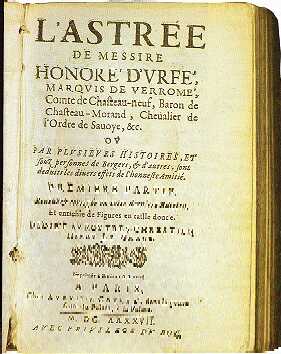L'Astrée on:
[Wikipedia]
[Google]
[Amazon]
 ''L'Astrée'' is a pastoral novel by
''L'Astrée'' is a pastoral novel by
Deux visages de l'Astrée
' (Two Faces of L'Astrée), Digital online critical edition of the three parts of L'Astrée published by the author during his lifetime (1607, 1610, 1619, and the last complete edition revised by the author in 1621). The site also offers a modern French version of these three parts. Posthumous Part Four is being edited. *Astrea, Steven Rendall's English translation of Part I, with an introductory critical essay, is available in the Medieval and Renaissance Texts and Studies series (1995).
 ''L'Astrée'' is a pastoral novel by
''L'Astrée'' is a pastoral novel by Honoré d'Urfé
Honoré d'Urfé, marquis de Valromey, comte de Châteauneuf (11 February 15681 June 1625) was a French novelist and miscellaneous writer.
Life
He was born at Marseille, the grandson of Claude d'Urfé, and was educated at the Collège de T ...
, published between 1607 and 1627.
Possibly the single most influential work of 17th-century French literature, ''L'Astrée'' has been called the "novel of novels", partly for its immense length (six parts, forty stories, sixty books in 5,399 pages) but also for the success it had throughout Europe: it was translated into a great number of languages and read at every royal court. Even today, this novel is regularly republished, both in full and in abridged edition, and even in comic book form. The first three parts were published in 1607, 1610 and 1619; after Honoré d'Urfé's death in 1625 the fourth was completed by Balthazar Baro Balthazar Baro (1596–1650) was a French poet, playwright and romance-writer.
Biography
Baro was born in Valence, Drôme, to a professor at the university of Valence. He studied at Tournon-sur-Rhône then at Valence, where he gained his law doctor ...
, and a fifth and sixth were supplied in 1626 by Pierre Boitel, sieur de Gaubertin.The attribution to "Borstet" is a frequent mistake caused by a misprint in Lenglet Du Fresnoy's ''De l'usage des romans'' (1735). The last two are often counted as one.
The plot is immensely complex, but the main thread of the storyline is the perfect love between a shepherd and shepherdess of fifth-century Forez
Forez is a former province of France, corresponding approximately to the central part of the modern Loire ''département'' and a part of the Haute-Loire and Puy-de-Dôme ''départements''.
The final "z" in Forez () is not pronounced in the Loire ...
, the heroine Astrée (named after Astræa) and her lover Céladon (who gave his name to the ceramic
A ceramic is any of the various hard, brittle, heat-resistant and corrosion-resistant materials made by shaping and then firing an inorganic, nonmetallic material, such as clay, at a high temperature. Common examples are earthenware, porcelain ...
). The perfidies and political ambitions of the other characters, which result in many misadventures for the couple, occupy the greater proportion of the novel, which is frequently interrupted by digressions into stories that are strictly unrelated but which serve to flesh out the world in which they live. D'Urfé's descriptions of Forez are sufficiently detailed for many locations to be identified without ambiguity. Visitors to Boën can today follow the ''chemins de l'Astrée'' ("paths of Astrée") by visiting the ''Grand Pré'' in the grounds of d'Urfé's old estate.
The most important editions are those of 1733, 1925 and 2006. A film version, '' Les Amours d'Astrée et de Céladon'', by Éric Rohmer
Jean Marie Maurice Schérer or Maurice Henri Joseph Schérer, known as Éric Rohmer (; 21 March 192011 January 2010), was a French film director, film critic, journalist, novelist, screenwriter, and teacher.
Rohmer was the last of the post-World ...
, was made in 2007. An opera by Gérard Pesson was performed in 2006 at the Stuttgart Opera, and in 2009 in Paris.
In his work ''The social destiny of man: or, Theory of the four movements'', Charles Fourier
François Marie Charles Fourier (;; 7 April 1772 – 10 October 1837) was a French philosopher, an influential early socialist thinker and one of the founders of utopian socialism. Some of Fourier's social and moral views, held to be radical ...
discussed celadony (''l'amour Céladonique''), describing it as purely spiritual love embodied by Céladon in ''L'Astrée''.Beecher, Jonathan (1990). ''Charles Fourier: The Visionary and His World.'' University of California Press, Hekma, Gert; Oosterhuis, Harry; Steakley, James D. (1995). ''Gay men and the sexual history of the political left.'' Psychology Press,
Bibliography
* ''Honore d'Urfé.'' Louise K. Horowitz. Boston: Twayne Publishers, 1984. * "L'astrée or Céladon the Dinosaur". Henry T. Harvey. ''The French Review'', Vol. 23, No. 3 (Jan., 1950), pp. 241–244. * Complete critical Edition, 2005–2014 : by Eglal Henein, Professor Emeritus of Tufts University.Deux visages de l'Astrée
' (Two Faces of L'Astrée), Digital online critical edition of the three parts of L'Astrée published by the author during his lifetime (1607, 1610, 1619, and the last complete edition revised by the author in 1621). The site also offers a modern French version of these three parts. Posthumous Part Four is being edited. *Astrea, Steven Rendall's English translation of Part I, with an introductory critical essay, is available in the Medieval and Renaissance Texts and Studies series (1995).
Notes
{{DEFAULTSORT:Astree 17th-century French novels 1607 books 1610 books 1619 books 1625 books 1626 books French novels adapted into films Novels set in the 5th century Novels set in France Forez Unfinished literature completed by others